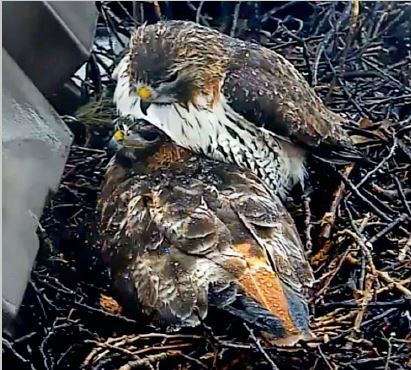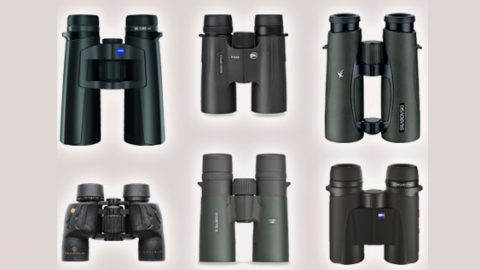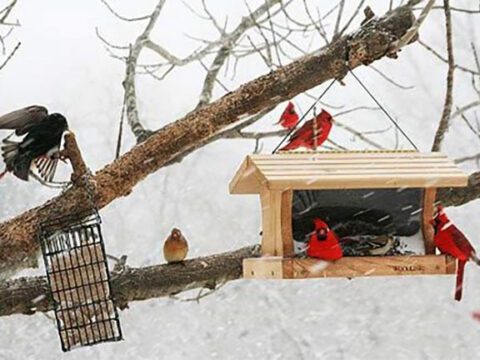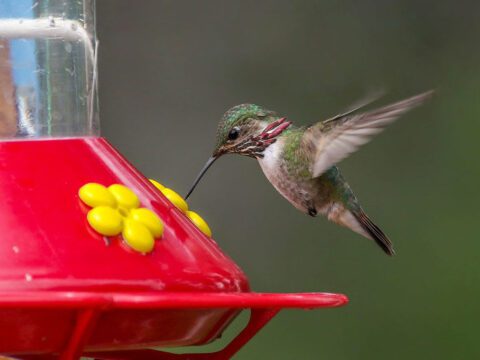View From Sapsucker Woods: Bird Cams Take Us Into the Lives of Birds
By John W. Fitzpatrick
October 15, 2013
Hosting a popular “avian reality show” has been an eye-opening privilege for all of us at the Cornell Lab these past two springs and summers. Our two contrasting top predators provide superb looks at the trials of offspring production in nature, at the division of labor so essential for monogamous birds to raise a successful brood, and even at the life-and-death challenges all young birds face.
The Great Blue Herons of Sapsucker Woods laid two successive five-egg clutches, fledging a remarkable quintet in 2012 and a threesome this past summer (two eggs failed to hatch). More than two million viewers around the world were riveted by high-definition images of daily life in the herons’ nest, and by new revelations about their biology. Surprising nighttime attacks by a Great Horned Owl produced bloodcurdling alarm screeches by the incubating female that to our knowledge had not previously been recorded. The patient endurance of both parents through heavy snow, driving rain, and howling winds bear witness to the physical difficulties that wild birds face every day while rearing young. The antics of youngsters in the nest reveal the crucial relationship between “play” and “practice” as bodies, necks, beaks, and wings slowly take on adult proportions and functions. I confess that even seasoned professional ornithologists are moved as these youngsters one-by-one launch from their lofty nest to take maiden flights and begin life in the real world. Do they realize, as we do, how much harder things will be for them in the days and months to come?
The now-famous Red-tailed Hawks of Cornell’s campus— Big Red and Ezra—also teach us much, and this year the Bird Cams’ faithful witnessed how difficult it is for juvenile birds to survive. Twice the pair has fledged three young, providing daily views of the difficulties of accomplishing this feat, including the moment during a windy downpour when the newly hatched nestlings were brooded by Big Red, who was being sheltered by Ezra (see photo above; watch the video at http://tinyurl.com/ Ezra-Big-Red). Differences between the two years reveal the flexibility with which raptors handle natural variations in prey densities. Chipmunks were super-abundant in 2012, and formed that year’s staple food item, but they appeared less frequently in 2013 when birds and snakes became more standard fare. That fledging occasionally occurs accidentally was demonstrated when the young hawk D2 slipped and hung upside-down by one stuck talon before dropping away. That accidental fledging can still succeed is beautifully illustrated by the remarkable series of photographs of D2 recently taken by an active local follower, posted on flickr.
It appears that D2’s two siblings were not so lucky. They were often seen flying around campus and hunting on their own until August 9, after a big storm. One hawk was found dead from blunt trauma, suggesting a collision with a vehicle or structure, and another was found with both legs severely injured, apparently from a mechanical accident. Despite valiant care by our colleagues at the Cornell School of Veterinary Medicine, its injuries were too extreme to allow a reasonable quality of life, and the bird was humanely euthanized. The outpourings of sorrow we received from our Bird Cams and Facebook communities underscore how powerfully humans connect with wild birds if given the chance to know them as individuals.
Red-tailed Hawks and Great Blue Herons can live up to 25 years, but for both species the majority of fledglings (55 to 70 percent) do not reach their first birthday. If, in addition to the wonders of hatching, development, and taking wing, our Bird Cams also reveal the sobering fact that survival is difficult for all young birds, then this reality show is accomplishing exactly what we intended. Understanding the precarious nature of birds’ lives helps motivate us to enhance their conservation. We are grateful for the appreciation and support we receive from viewers around the world, and we look forward to seeing what 2014 brings.

All About Birds
is a free resource
Available for everyone,
funded by donors like you
American Kestrel by Blair Dudeck / Macaulay Library





